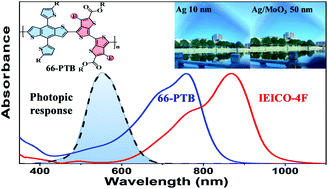A near-infrared polymer enables over 50% transmittance in semi-transparent organic solar cells†
Abstract
Semi-transparent organic solar cells (ST-OSCs) have shown great potential for integration into the windows of buildings. An absorption region that is dominated by photovoltaic materials is vital for ST-OSCs. However, the state-of-the-art polymer donors are not specially tailored for ST-OSC applications and have a strong absorption in the visible region. Therefore, two polymers, namely 44-PTB and 66-PTB, are rationally designed by combining a benzodithiophene and two fluorinated thienothiophenes (FTT) in the repeat unit. Benefiting from the donor–acceptor–acceptor (D–A–A) configuration, the intramolecular charge transfer (ICT) effect is thus enhanced to red-shift the absorption of the corresponding polymers. Meanwhile, the regioregularity caused by the asymmetric structure of the FTT significantly affects the molecular geometry of these polymers. Compared with 44-PTB, 66-PTB with a more planar skeleton has a bathochromic and strong absorption in the near-infrared (NIR) region, which is conducive to improving the photon harvest and transmittance. In addition, the relatively planar backbone helps 66-PTB to achieve better intermolecular packing and form a fibrous structure in the film. As the result, the opaque device based on 66-PTB achieved a PCE of 7.84%, while the PCE of the device based on 44-PTB is only 5.93%. More importantly, ST-OSCs based on 66-PTB realize an average visible transmittance (AVT) as high as 50.82% accompanied by a PCE of 5.11%, which is among only a few ST-OSCs with a >50% AVT. The color rendering index (CRI) is 74.09, and the colour coordinates are (0.294,0.338), which are meet the requirements of windows used in civil architecture.



 Please wait while we load your content...
Please wait while we load your content...